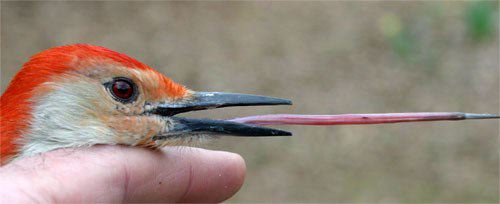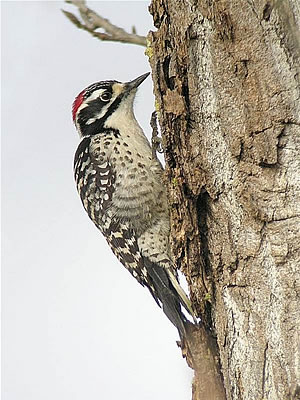I've seen quite a few woodpeckers recently, and I don't think they're ugly birds at all. I'm not sure I would say any bird was ugly except maybe a vulture. But let's put the question of beauty or ugliness aside for now and just talk about woodpeckers.
- Woodpeckers have very strong, pointed beaks that they can use like a hammer to knock against trees and also like a chisel to dig bugs out of the bark.
- They also have very long tongues, which further help in ferreting out bugs.

Woodpeckers don't just have long, stiff beaks, they also have very long tongues, as this photo of a red-bellied woodpecker demonstrates.
(Photo from the Hilton Pond Center)
- Woodpeckers knock their beaks against trees for a variety of reasons:
- to drum up insects tucked among the crevices of bark
- to make holes in the trees that become their nests
- to communicate courtship signals to other woodpeckers in the area
- Woodpeckers knock wood somewhere between 8,000 to 12,000 times a day.
- Whenever I hear one, I'm always impressed at how fast the beats fall -- how do they move their heads back and forth fast enough to knock that fast -- and how loud it is. The sound is so loud, it echoes for tens of yards.
- There are lots of different species of woodpeckers -- somewhere between 180 and 220 of them.

Here are 9 types of woodpeckers. Reading in order L to R top down: 8) flicker 1) red-cockaded 2) hairy 3) downy 7) sapsucker 6) red-headed 9) ivory-billed 4) pileated 5) red-bellied
(Brochure from the US Fish & Wildlife Service)
- Woodpeckers have been seen in every part of the world that has forests, except in Australia.
- One of the largest species is the ivory-billed woodpecker. It's about 20 inches long, has a 3-foot wingspan, and can weigh over 1 pound. Only the imperial woodpecker in Mexico is larger.
- It was thought to be extinct, but someone spotted the bird in Arkansas in 2005, though it has been hard to find again since then.
This is huge. It's kind of like finding Elvis.
--Frank Gill, a past president of the Audubon Society, when he heard the news that someone had seen the ivory-billed woodpecker.
- The pileated woodpecker is the third largest woodpecker in North America after the ivory-billed, and they are much more common. These are nearly as large as crows, and the holes they make in trees are often rectangular-shaped.
- 'Pileated" is pronounced "PY-lee-ate-ed." The word means having a cap over the whole top of the head. It comes from the Latin word "pileus," meaning a felt cap with no brim. That old felt cap, too, covered the entire top of the head.
- Pileated woodpeckers have the distinctive red peaked head and black and white stripes across the face.
Pileated woodpecker with the famous red crested head. I don't know if you can tell, but the photo is a little blurry where the bird is tapping super-fast against the trunk.
(Photo from Avian Web)
- Their call is a high-pitched, somewhat nasal, and fast-repeating chirp-chirp-chirp-chirp-chrip. The call, too, is very loud and carries, echoing, through the trees.

The Pileated is probably the woodpecker on whom Woody was based. I freakin' hated Woody Woodpecker, by the way. He annoyed the daylights out of me. The real bird is far less irritating.
(Photo from iOffer.com)
- The Nuttall's woodpecker is much smaller, and it has black and white stripes across its back and its wings. It is also missing the signature peak that we've all come to identify with woodpeckers, though it does have a red cap.

The Nuttall's Woodpecker is distinguished from its very similar fellow the Ladder-backed woodpecker by the thick black stripe at the base of its neck. The Nuttall's lives in California almost exclusively.
(Photo by Harry Fuller at Towhee.net)
- The Hairy woodpecker is smaller yet. The male has just a little spot of red at the back of his head, while the female has no red spot at all.

The hairy woodpecker is distinguishable from is near-lookalike fellow the downy woodpecker primarily by the length of its beak: the hairy woodpecker's beak is longer than half its head. Now, if you could just measure the woodpecker's beak and head before it hops or flies away. . . .
(Photo by Gordon Ellmers from About.com)
- The Acorn woodpecker drills a bunch of holes in oak trees and fills the holes with acorns they've collected. They may pack the acorns so tightly into the holes, even squirrels can't prise out the nuts.

Acorn woodpeckers can cause a lot of damage, not just to trees but also to fence posts, wood-sided buildings, and as in this case, telephone poles.
(Photo by Sue Bryan at Norfolk Birders)
- Sapsuckers and flickers -- which have calls very similar to pileated woodpeckers though not as loud -- are part of the same family as woodpeckers. They are all classified as Picidae.

The famous yellow-bellied sapsucker. As you can see, it really does have a yellow belly. It also looks a lot like a woodpecker -- which is why it's part of the same family.
(Photo from Urbee Car)
- If woodpeckers are drumming holes into your property and you want them to knock it off, here are some of the best methods to keep them away:
- Put metal mesh over areas they have tended to drill into.
- Put up statues of owls or snakes. Be sure to relocate the statues now and then so the birds don't get used to them
- Go outside and clap your hands loudly every time you hear the bird hammering. Do it enough times and the bird may get the message.
- Some sticky repellants such as 4-the-Birds and Roost-No-More have been successful.
- For more suggestions and specific instructions, see the Internet Center for Wildlife Damage Management.
Sources
Defenders of Wildlife, Woodpeckers
Thomas H. Maugh, II, "Long thought extinct, a species of woodpecker sails back into view," boston.com, April 29, 2005
Cornell Lab of Ornithology, All About Birds, Pileated Woodpecker
Onelook.com, pileated
Shaw Creek Bird Supply, North American Woodpecker Species
Professional Pest Control Supplies, Woodpeckers
Huh-huh-huh-ha-ha.
ReplyDeleteUgh, hate that thing.
ReplyDeleteI hate Woody Woodpecker too.
ReplyDeleteVultures not ugly!
ReplyDeleteI think woodpeckers are pretty birds
ReplyDeletei have a woodpecker out side my house... i know it needs a house its always bothering us.. but don't kill them..save them... they need a house now and we are the only ones to help them...there in danger of extinct save them we don't want them to leave our word...right?
ReplyDelete